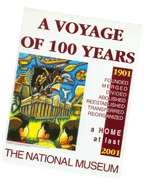OFFICE OF THE DIRECTOR
The Director's Office
One may find it rather unthinkable if twelve large and diverse divisions exist in the National Museum, each functioning independently or autonomously, and yet, there is no coordinating body that administers their respective programs f and activities. Can you imagine the chaotic and multi-directional working atmosphere in the agency if such is the case?
Fortunately, this is not so. For no organization will ever come to existence at all without a central force and figure. In the case of the National Museum, this central figure is the Directors' Office.
The Directors' Office manages the twelve different divisions of the National Museum system, formulates micro and macro development plans and programs, establishes priorities for the utilization of funds, manpower, equipment and other resources, and establishes linkages as well as working relationships with various government agencies. Four working units are severally responsible for performing this multi-faceted role: the Planning Unit, the Legal Unit, the Internal Audit System Unit, and the Information Technology Unit.
Planning Unit
The Planning Unit is basically tasked to develop short-term, medium-term and long-term plans for the agency. Also known as the "think tank" of the Museum, the Planning Unit is responsible for providing the Directors with economical, efficient, and effective services relative to planning and project development as well as coordinating the implementation of approved plans and programs. The Unit also maintains linkages with government and non-government agencies/institutions and assist in information dissemination campaigns of the Museum.
Legal Unit
As its name implies, the Legal Unit takes care of the legal affairs of the National Museum and provides the Directors' Office with pertinent legal advice and recommendations.
Internal Audit System Unit
Serving as watchdog of the government in the National Museum is the Internal Audit System Unit. This group ensures that all disbursements of funds, procurement of supplies and equipment, etc. are in proper order and of correct costs. The Unit also undertakes a periodic inventory of National Museum properties in order to safeguard and protect government properties.
Information Technology Unit
The Information Technology Unit provides administrative services to the Directors' Office through cybertechnology and other computer-related services. It handles a broad range of technologies inyolved in information processing and handling such as computer hardware, software, data communications, and office automation including maintenance and development of appropriate programs and materials for the promotion of Philippine art and culture.
From the use of the Apple Computer, IBM XT model and dbase 3 plus software program way back in the early 1980s, the National Museum has developed the use of more sophisticated technology not only for the purpose of effective documentation of research projects, but also to improve the dissemination of new fmdings and information about the nation's cultural and historical assets. Museum publications as well as exhibits have been transformed into interactive multimediaCD-ROM programs. Graphics have been integrated into large databases and stored in CD's for the specialist's use. Finally, information from museums are made available through the Internet - the booming electronic medium of the future. Art enthusiasts, students and researchers may now visit the National Museum website.
taken from the
"A Voyage of 100 Years"



